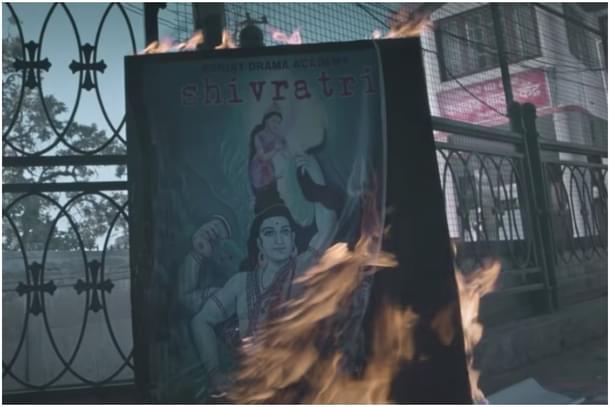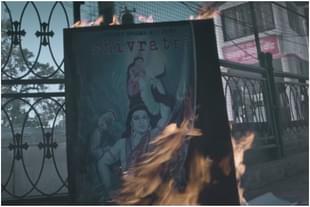Culture
'The Kashmir Files': What It Means To A Hindu Living In Kanyakumari
Aravindan Neelakandan
Mar 17, 2022, 03:54 PM | Updated 05:11 PM IST
Save & read from anywhere!
Bookmark stories for easy access on any device or the Swarajya app.


The ethnic cleansing of Kashmiri Hindus was one of the defining moments of Hindutva of anyone’s life who was sensitive enough about Hindu issues, and who grew up in the late 1980s and early ‘90s.
In the early ‘90s, two important events happened in Tamil Nadu which made Kashmir issue an intensive one – at least for me.
On December 11 1991, Dr. Murali Manohar Joshi, the then president of the BJP, started his Unity march (Ekta Yatra) from Kanyakumari. The aim was to unfurl the National Tricolour at Lal Chowk, Srinagar, defying the threats from the terrorists. The date was the birth anniversary of Tamil poet, Subramanya Bharathi and the day of the supreme sacrifice of Guru Tegh Bahadur – who gave his head to protect the sacred thread and vermillion of Kashmiri Hindus.
The flag was handed to Dr. Joshi by Javeed Aslam, the son of Abdul Hamid, who was decorated with Param Vir Chakra for his legendary destruction of eight Pakistani tanks in 1965 war. Kanyakumari district was covered in National Tricolour and the whole district was surcharged with a feeling for Kashmiri Pandits.
Then came in 1992 the movie Roja, directed by Mani Ratnam. It was released on 15 August. When it was released in Kanyakumari district, there was opposition from ‘a group of radicalized youths of a particular community’ (as they used to report those days) and ABVP had pasted posters near the cinema hall congratulating the movie team. That was the first movie where the audience, particularly the youths, were checked by the police before entering the movie hall. There were spontaneous eruptions of ‘Bharat Mata ki Jai’ in the theatre when the protagonist of the movie rolls over the National Tricolour as terrorists set fire to it.
The movie went on to become a national blockbuster. A few years later, Mani Ratnam would survive a bomb attack on his house.
Thus, the genocidal attacks on Kashmiri Hindus and their ethnic cleansing became a defining emotional memory for Hindutvaites in this part of the nation – Kanyakumari.
That brings one to the 2022 movie The Kashmir Files, directed by Vivek Ranjan Agnihotri. The movie tells the story of the ethnic cleansing of Kashmiri Hindus with brutal honesty.
The futility of Hindu defence mechanisms against civilisational tragedies has been shown clearly.
One such mechanism is denial. ‘Your parents and brother died in an accident.’ That leads the descendent of the victims right into the laps of the killers of his parents and brother. He becomes their ideological foot soldier.
Another one is what most of us do. We tend to impose our own worldview upon the aggressor and humanise or even spiritualise his violence. The grandfather gives a typically Hindu meaning to the hate slogan ‘convert or die or leave’. Ultimately, the child gets shot.
We do this. We naturally tend to do this. This is a very inhuman price we pay for the spiritual magnificence of this civilisation. But this is also destroying this very civilisation and it is bringing pain so intense that it can scream only in silence. These defence mechanisms are delusional and fallacious. They will lead us only to the pit into which our children will be nameless and numbered corpses with bullet holes in their heads.
The Islamist doublespeak is another important aspect highlighted by the movie. The solution for all problems, the terrorist leader says to the frenzied stormtroopers, is ‘Holy Jihad’ and the very same statement is later told to the son of the victims by the same terrorist who had gunned down his parents but with a little difference – the solution for all problems is Mohabbat (love). The terrorist knew he was the one who murdered the parents and brother of the protagonist and he also knew that the latter did not know that. And the concocted equivalence between al-Jihad and 'mohabbat' is a strong pillar of the leftist-Islamist narrative. The director should be congratulated for exposing these deeper and darker aspects of the Establishment.
The movie also shows that moderate Muslims and non-Pandit Hindu communities too were targeted and killed by the Islamist terrorists. But the focus of the movie is ethnic cleansing and targeted killing of the Kashmiri Pandit community – not because they were Pandits but because they were Hindus.
The movie presents the perverse tendency of the Left in acting as an ideological facilitator of 'Breaking India' forces without caricaturing it.
The bullet of the terrorist entering the head of the Hindu child kills it immediately while what the Left pushes inside the heads of the children in our educational establishment kills the very essence of the civilisation – making the child an ideological zombie.
Roja in 1992 spoke about the Pandit refugees for the first time. It did not mention the community by name – either their ethnicity or their religious identity. In a conversation between a terrorist and the kidnapped protagonist, the question of the plight of the refugees from Kashmir comes up.
The movie came just a year-and-a-half after the ethnic cleansing and yet it had to ask the questions in an indirect manner.
Kashmir Files doesn't go that way. It shows us what happened. And we had to wait for three decades for such a movie to come.
Naturally, the disinformation campaign also has started. 'Was it not a Janata Dal government supported by the BJP that was in power when the ethnic cleansing happened?' 'How many Kashmiri Hindus really died? (not dissimilar to the notorious ‘Did six million really die?’)'; 'Kashmiri Pandits were not the only target (‘German non-Jews were also killed’)'; and the worst of them all - 'Jagmohan engineered the exodus (‘Zionists planned the Holocaust’)'.
One should remember that Rajiv Gandhi removed Jagmohan as governor of Jammu and Kashmir to placate another dynast, Farooq Abdullah. Before Rajiv, the government under his mother Indira Gandhi had effectively handed over education in Kashmir to the Jamaat-e-Islami.
It is amazing to see today that J-e-I pamphlets of ‘80s speak the same language as JNU does today – 'fighting the Brahminical Indian State'. It was this infrastructure which was seized by Pakistani intelligence agencies.
J-e-I indoctrinated Islamists provided human resources for the terrorist movement. When Indira Gandhi realised her follies, things in Kashmir were already out of Delhi’s hands. It was in such a situation that Jagmohan became the Governor and set himself to make things right. He faced opposition from the Farooq Abdullah regime. It was under Abdullah's tenure that there were riots engineered by Islamists in February 1986. It was the Kristallnacht that came before the Holocaust. Hindu houses were targeted – 338 houses were burnt, 62 houses were looted, 55 temples were looted, burnt or desecrated, 50 business establishments were looted or burnt. The riots delivered a message – Kashmir is not for Hindus.
It was these riots that should have made Jagmohan realise the truth of what was happening. Himself a refugee from Pakistan, it should have been déjà vu for him. He saw incompetence and corruption collude with terrorism and Hindus becoming targets of hatred. As he started defending the integrity of India, the pressure to remove him from the Governor post grew. Ultimately, he was removed.
Terrorists got a boost and India lost.
Jagmohan was again re-appointed during the V.P.Singh period in January 1990. India Today then reported the animosity Rajiv Gandhi had for Jagmohan and how it helped the terrorists in the valley:
But the last thing that Jagmohan's detractors - among them Farooq and Rajiv whose handling of Kashmir threatens to be exposed the longer Jagmohan stays on - want is to see him emerge as a hero or a peacemaker. One of the immediate aims of these forces is to turn the anti-Farooq sentiments in the valley - that had taken on a stridently anti-Indian tone - into an anti-Jagmohan wave. They were partly successful, at least in Srinagar, following the January 20 searches ordered by Farooq's bureaucrats who blamed the excesses against civilians on Jagmohan.India Today, February 28, 1990
This is what Kuldip Nayar, an anti-RSS columnist, wrote then condemning the removal of Jagmohan as governor:
When Rajiv Gandhi removed Jagmohan from governorship on his report against Farooq Abdullah' s softness towards militants, it was clear that New Delhi did not want to face facts.Kuldip Nayar, The Tribune, 21-December-1989
How was the administration of Jagmohan? Even the then Home Minister Mufti Mohammad Sayeed in the meeting of the Consultative Committee of Members of Parliament acknowledged how the governor, through his firm action, was bringing back the law and order situation. He pointed out how, after two years, Republic Day was being celebrated for the first time. (The Hindustan Times, 28-January-1990)
But Jagmohan was forced to resign five months later.
In other words, whether it was Indira Gandhi, Rajiv Gandhi or V P Singh, they did not seem to care for the sufferings of Hindu minority in Kashmir.
It was the Hindutva movement alone which challenged this powerful narrative of the establishment.
That is why this movie is important. Do not for a moment think that some special situations in Kashmir had caused the ethnic cleansing of Hindus. This is also the story of Hindu Jamatiyas in Tripura. This is also the story of Hindu Reangs from Mizoram, now refugees for decades in Tripura. It is also the story of Hindus in pockets of villages in Kanyakumari district.
We all remember how, in 1982, fanatical Christians chased Hindu women who had gone to take a ritual bath in the seas of Kanyakumari and made them made them run for their lives, unclothed.
If Kashmir Files were a person, then it would be Moishe the Beadle of Elie Wiesel’s Night. What the movie tells is not just the past of the Kashmiri Hindus. It is also telling the future of our children if we chose denial and disunity.
It is into that future of our children that the still eyes of Shiva Pandit are staring.





